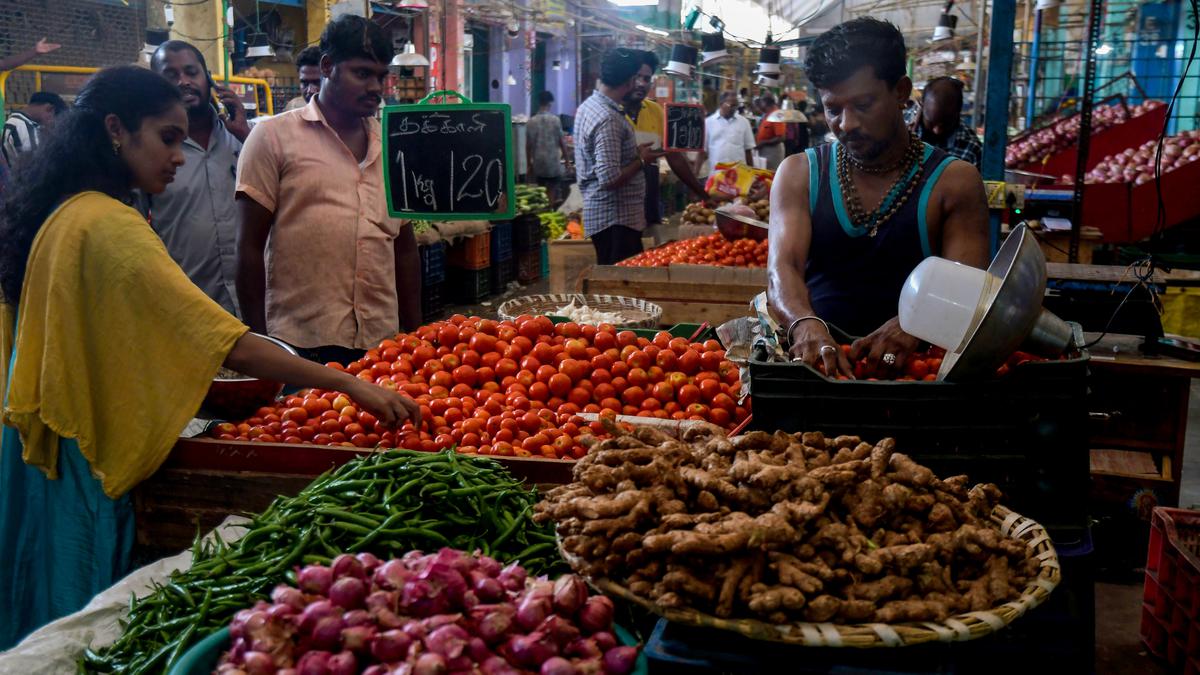
The lingering bitter taste of price rise Premium
The Hindu
Extreme weather events have caused a shortage of commodities and pushed up prices in Tamil Nadu, affecting consumers' food choices and spending. To cope, people are improvising recipes, using cheaper vegetables, cutting down on dining out and switching from packaged food to home food. Restaurants are also finding it tough and may have to reconsider prices. Rice prices have also increased due to higher electricity charges and labour costs. Farmers are not benefiting from the higher prices and demand better cold storage, water resources and MSP. The State govt. has resorted to interventions, such as tomato sale at fair price shops and farm fresh outlets, to stabilise prices.
Rain or shine, any extreme weather condition influences the supply and prices of commodities every year in Tamil Nadu. This time, extreme weather events — a record heat wave in June, succeeded by an unprecedented rain in many supply States — have compounded the shortage and pushed up the prices.
The sustained surge in the food prices in the State has affected the food choices and purchasing power of consumers; given the fixed monthly incomes, it has had a cascading effect on consumer spending on healthcare, electricity, transport and entertainment.
Consumers are confronting the phenomenal increase in the prices of vegetables, especially of tomato, that is hitting new highs daily, thereby altering consumption patterns. The prices of pulses and food grains such as rice and tur dal — though they have a longer shelf life than vegetables — have also been rising, leading to people using these commodities frugally. Many persons claim they have been forced to improvise recipes to shield themselves from the rising retail food prices.
In her struggle to make ends meet, Aarti Santosh, of Thiruvanmiyur in Chennai, has been trying out innovative recipes. “I substitute roasted grams for tomatoes in gravies and use roasted chickpeas powder to brew coffee to manage my household budget. I spend 40% more on food a month. My weekly budget for fruits and vegetables has climbed from ₹700 to almost ₹1,300. My budget on healthcare, transport and even entertainment has been compromised because of the food cost,” she said. Small yields from terrace gardens, choice of locally grown, cheaper vegetables, cutting down on dining out and switching from packaged food to home food are some of her strategies to cope with the situation.
Residents note that the rising food prices have further dented their budget that has already gone awry with a steep increase in electricity tariff. Besides the higher tariff, some consumers bore the brunt of higher charges for new power connections, security deposits and replacement of meters.
While some residents switched to public transport, others chose lesser-known brands and cut down on eating out and ordering food online. Though the prices of a few vegetables went up during non-seasonal time, residents in Tiruchi said it was probably the first time in recent years that the prices of several essential items had increased abnormally. “I shell out ₹300 for one kg each of tomato and small onion alone. My regular spending on vegetables has gone up to ₹1,500,” says M. Vasudevan, an electrician who regularly visits the Gandhi Market.
The working class in Tiruppur is among the worst affected by the rising cost of groceries. Joblessness has forced most of these families to buy rice from fair price shops alone. “The retail inflation must be curbed. People are forced to pledge jewels to pay their food expenses,” said N. Shanmugasundaram, president of the Nallur Consumers Welfare Council. Restaurants have been finding the going tough too. Uma Hari of GalaGala Nest that runs Mamee Soups in Chennai said customers complained that they found the cost quite high. “We avoid expensive vegetables in dishes. We have switched to packing and selling individual items rather than the regular sets,” she said. Using packages purées instead of tomatoes is also another strategy.











